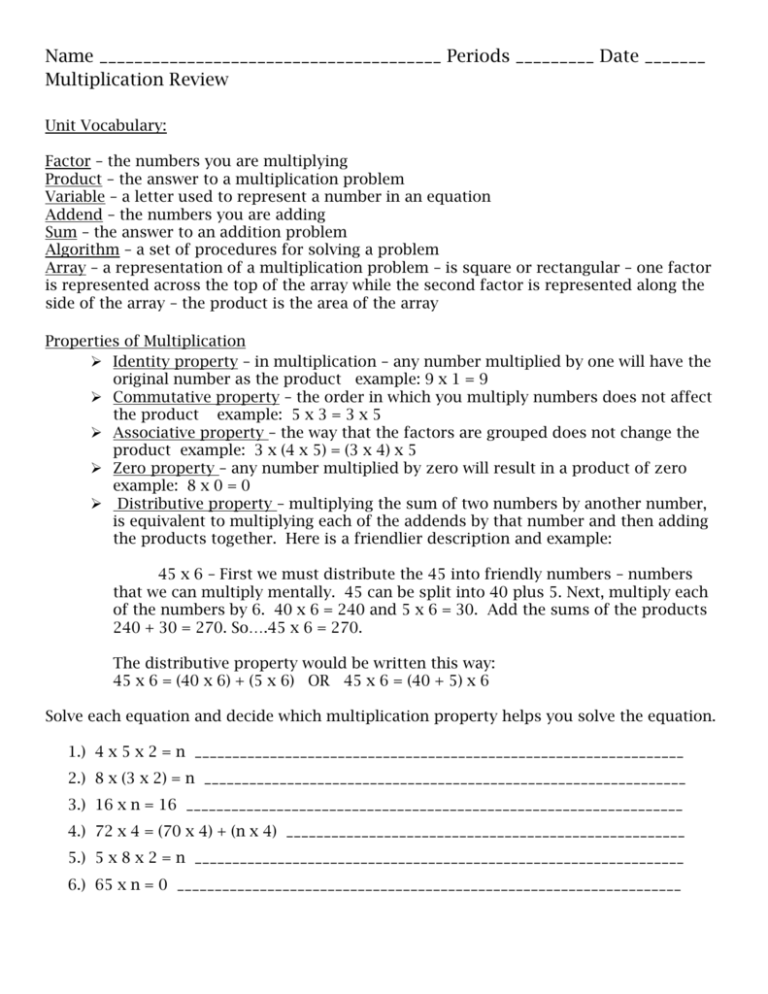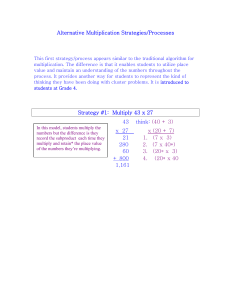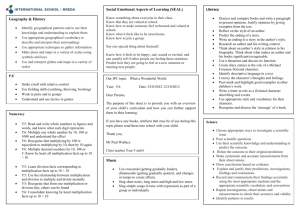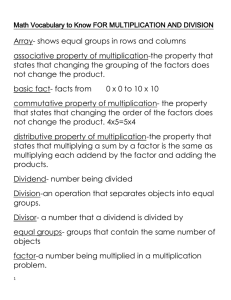Multiplication Review
advertisement

Name _______________________________________ Periods _________ Date _______ Multiplication Review Unit Vocabulary: Factor – the numbers you are multiplying Product – the answer to a multiplication problem Variable – a letter used to represent a number in an equation Addend – the numbers you are adding Sum – the answer to an addition problem Algorithm – a set of procedures for solving a problem Array – a representation of a multiplication problem – is square or rectangular – one factor is represented across the top of the array while the second factor is represented along the side of the array – the product is the area of the array Properties of Multiplication Identity property – in multiplication – any number multiplied by one will have the original number as the product example: 9 x 1 = 9 Commutative property – the order in which you multiply numbers does not affect the product example: 5 x 3 = 3 x 5 Associative property – the way that the factors are grouped does not change the product example: 3 x (4 x 5) = (3 x 4) x 5 Zero property – any number multiplied by zero will result in a product of zero example: 8 x 0 = 0 Distributive property – multiplying the sum of two numbers by another number, is equivalent to multiplying each of the addends by that number and then adding the products together. Here is a friendlier description and example: 45 x 6 – First we must distribute the 45 into friendly numbers – numbers that we can multiply mentally. 45 can be split into 40 plus 5. Next, multiply each of the numbers by 6. 40 x 6 = 240 and 5 x 6 = 30. Add the sums of the products 240 + 30 = 270. So….45 x 6 = 270. The distributive property would be written this way: 45 x 6 = (40 x 6) + (5 x 6) OR 45 x 6 = (40 + 5) x 6 Solve each equation and decide which multiplication property helps you solve the equation. 1.) 4 x 5 x 2 = n _________________________________________________________________ 2.) 8 x (3 x 2) = n ________________________________________________________________ 3.) 16 x n = 16 __________________________________________________________________ 4.) 72 x 4 = (70 x 4) + (n x 4) _____________________________________________________ 5.) 5 x 8 x 2 = n _________________________________________________________________ 6.) 65 x n = 0 ___________________________________________________________________ A Multiplication Short Cut When you are multiplying multiples of 10, 100 or 1,000, just write the answer to the basic fact that is in the problem and then count the zeros in the factors and put that many zeros in your answer. Example: 400 x 20 = 8,000 (4 x 2 = 8 and there are three zeros in the factors) 7.) 40 x 50 = ________ 8.) 300 x 20 = _________ 9.) 8 x 900 = ________ Estimation steps: Find the greatest place value. This is the place value that is worth the most. Example: 3,475 – the 3 is in the thousands place, which is worth more than the other place value in this number. Round to that place value. Multiply the rounded numbers. First, solve the basic fact. Write that number down. Count the zeros in both factors. Write that many zeros beside the answer to the fact. Put commas where they belong. Example: 3,475 x 75 = about 3,000 x 80 which equals 240, 000 Estimate by rounding to the greatest place. 10.) 45 x 54 _____________________________________________ 11.) 872 x 9 _____________________________________________ 12.) 8 x 325 _____________________________________________ 13.) 5 x 76 ______________________________________________ 14.) 123 x 456 ___________________________________________ Arrays This array shows 28 x 4. The 28 is shown by 2 tens blocks and 8 ones blocks. There are 4 groups of 28 in the array. 20 4 20 x 4 = 80 and 8 x 4 = 32 so 28 x 4 = 114 8 This array shows 3 x 5, which is 15. 3 5 **Be sure you can outline an array on graph paper!** Multiplication Methods: Multiplying by single digit numbers: 2 74 First, multiply the ones places : 5 x 4 = 20. Write the 0 in the ones place x 5 of the answer and regroup the 2 because it means 20. Next, multiply 370 5 x 7and add on the 2 which was regrouped. 35 + 2 = 37 Solve using an algorithm of your choice. Show your work on the back of this page if you need more room. 15.) 62 x 7= _________ 16.) 93 x 4 = _________ 17.) 508 x 9 = _________ Multiplying by two-digit numbers: Partial Product Algorithms: Traditional Algorithm: 78 X 70 8 x 25 20 1,400 160 X 25 350 40 390 5x8= 40 5 x 70 = 350 20 x 8 = 160 20 x 70 = 1,400 1,950 5 1,400 + 160 + 350 + 40 = 1,950 78 Don’t forget to regroup. When multiplying by the +1560 tens place, use a 1,950 zero as a place holder. Solve each problem using an algorithm of your choice. Show your work on the back of this page if you need more room. 18.) 92 x 67 = _________ 19.) 80 x 24 = _________ 20.) 913 x 57 = _________ Problem Solving Addition – taking groups and putting them together to get a TOTAL Multiplication – taking EQUAL groups and putting them together to get a TOTAL Subtraction – taking the TOTAL and getting rid of part of it or comparing (how much bigger, smaller, fatter, wider, taller, more, less, etc.) Division – taking the TOTAL and splitting it into EQUAL groups Remember - in addition and multiplication you are calculating a total while in subtraction and division, you know the total and you are getting rid of or splitting it into groups. Some problem solving strategies: Draw a picture Act the problem out in your mind Look for patterns Guess and check Look for clue words for estimation: about, approximately, estimate Solve each word problem. Show your work. 21.) A purple marlin eats 125 mosquitoes in a day. About how many mosquitoes will a purple marlin eat in one week? 22.) After a class field trip to an animal habitat, class members can order photographs to remember the day. Fifteen students out of a class of 26 order two prints each. The rest of the class ordered three prints each. How many pictures were ordered by the class? 23.) Sheila’s horse Champion exercises 2 hours each day. Champion eats 105 pounds of hay each week. How much hay will Champion eat in a year? 24.) It takes Adam’s grandfather 27 hours to carve one wooden bird. How many hours would it take him to carve 62 birds? (One bird for each 5th grader!!) 25.) If Adam’s grandfather finished 49 carved birds, how many more birds does he have left to carve so that each 5th grader can have one?







